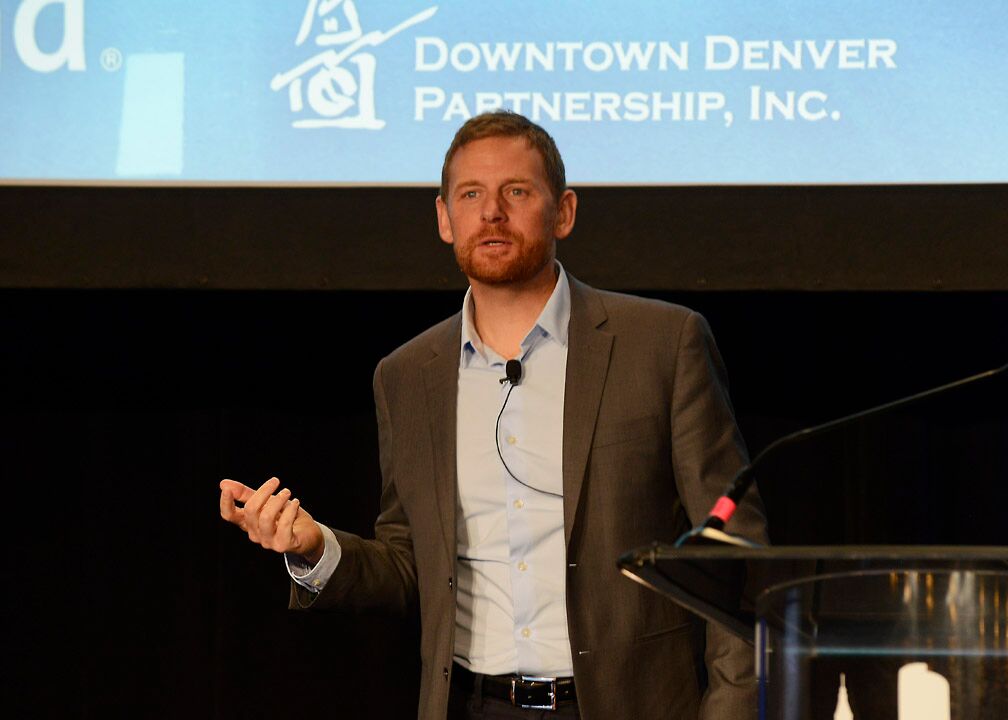“Happy City” Author Charles Montgomery Talks Colfax, the A-Line, and Bikes

Charles Montgomery is not okay with the trauma of crossing Colfax Avenue, Colorado’s highway expansions, or bike lanes that aren’t protected from speeding traffic. And though he’s glad voters agreed to pay for it, he’s a little suspect of RTD’s A-Line to and from the airport.
Montgomery is the author of “Happy City: Transforming Our Lives Through Urban Design.” It’s about the relationship between cities, science, and human well-being — about “seeing our city streets, hearts, and mobility systems as emotional infrastructure that can make or break he health or happiness of our citizens,” he says.
Montgomery spoke Thursday at the Downtown Denver Partnership’s annual Rocky Mountain City Summit, a get-together of more than 700 “city builders” from Denver and the west. The day was packed with people talking and learning about this year’s theme, “The City of the Future,” and Montgomery helped kick it off. Here are some Denver-centric things he had to say.
On Colfax Avenue and Making Vision Zero More Than a Slogan
“We need to think about how the walking experience feels, how streets make us feel. This is East Colfax Avenue,” Montgomery said, showing the audience some familiar pictures of people playing Frogger in an attempt to cross the urban highway. “Just imagine how you would feel crossing that street. Super. Scared.”
As part of his research, Montgomery put sensors on people crossing streets like Colfax, and found that people are, in fact, super scared — just to cross a street! “And you know what, it should feel scary,” he said. “Six people killed there in 2015. You have this group here called WalkDenver,” Montgomery said, commenting on the advocates’ push to get pedestrian-friendly streetscape improvements on Colfax into Mayor Michael Hancock’s budget. “I don’t think this intervention is being funded in this year’s budget, and this stuff really needs to be. The city has adopted Vision Zero. That means it’s not okay for anybody to die by car. So you need to get on it.”
On Standard Bike Lanes Versus a Robust Bike Lane Network
“I’m not gonna talk about biking, except to say one thing: See that?” said Montgomery, pointing to a picture of a standard, striped bike lane. “That’s a bike lane. If you build those all over your city, you will never get more than 7 percent of people commuting by bike. I promise you. Because it’s too scary. You need safe, separate lanes.” (See: Protected bike lanes on Lawrence and Arapahoe streets.)
“Bike lanes are a great baby step from the 1990s,” Montgomery said. “Cities around the world who have success by creating more freedom by giving more people the opportunity to move in various ways by bike, you only succeed if you build a connected network of safe, separate bike lanes — places where people aren’t scared about getting run over.”
On Funding Transit and RTD’s A-Line
Montgomery lauded Denver metro voters for approving FasTracks back in 2004, but also picked on RTD for the A-Line’s delays.
“The mayor earlier said that Denver is getting a reputation around the world,” Montgomery said. “And I’ll tell you, you have a reputation in my city, Vancouver. Last year, we decided not to pay a little bit more per citizen per year to have a great transit system. And so I was so excited to arrive yesterday and take the ‘A’ train right into Union station — even though a lot of people said, ‘Don’t do it’… And I’m told, if I take the train back to the airport tonight, I might miss my plane.”
He applauded Seattle’s newest light rail lines, which drop passengers off in walkable areas with lots of things to do, but warned against “what Dallas did, which built this huge light rail network to nowhere and they saw their ridership go down.” Walkability around RTD’s stations, even its new ones, isn’t always great, but Montgomery praised the walkability and activity around Union Station.
“We have an overwhelming amount of evidence to show that those connections — positive connections of any kind — they’re good for our souls, they’re good for our health, they’re good for the economy,” Montgomery said. “And we have evidence to show that the way we build places can draw us together or push us apart. So we believe that if we build for happiness, and specifically if we build for social connections, we can create cities that are healthier, happier, more resilient, fairer, cities that actually bring out the best in us. And I’ve been seeing in Denver how you’ve begun that journey, and look forward to hearing how all of you plan to continue it.”


